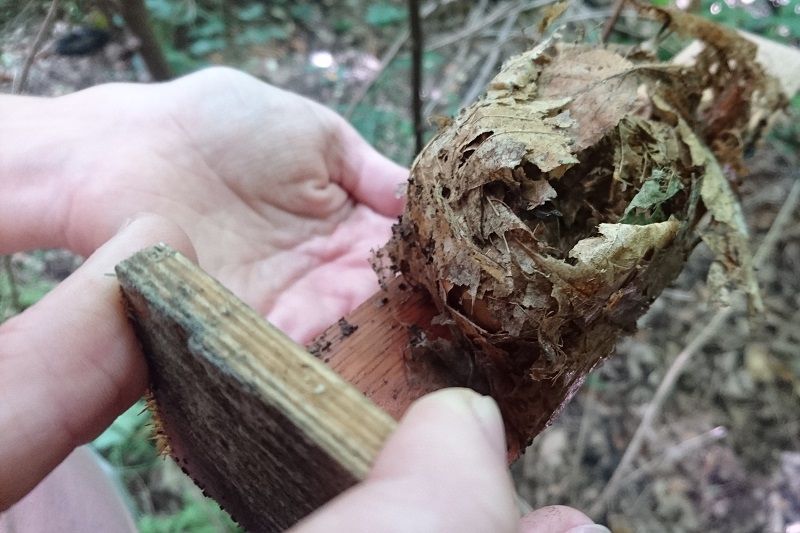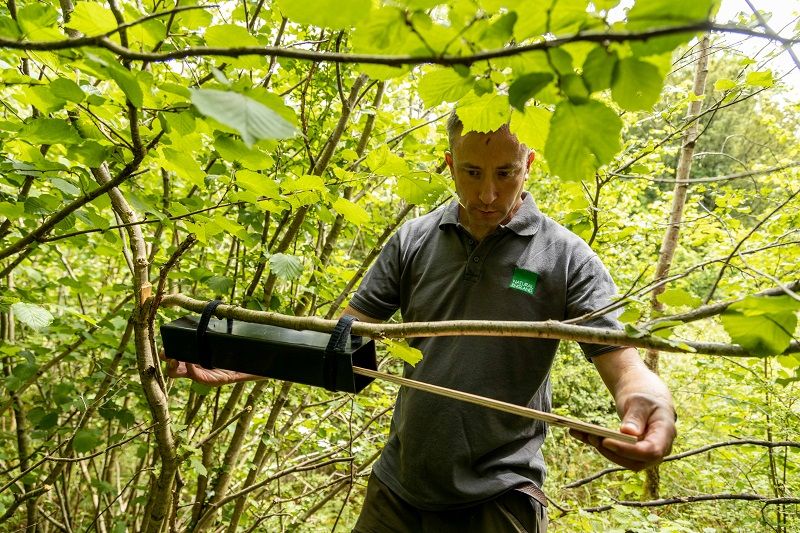Negative records are important
Finding hazel dormice isn’t easy. And it’s even more difficult to prove that they’re absent from a particular patch. But dormice are protected in law. So, when new houses are built or roads expanded, the developers must ensure that any hedges, shrubby habitat or woodlands that are likely to be disturbed or destroyed, are thoroughly checked to see if dormice are present.
The current tried and tested method used in England and Wales is nest tubes: long plastic tunnels with a wooden insert. They’re placed in hedgerows or hanging horizontally from branches and checked regularly for evidence of nests. Both Natural England and Natural Resources Wales – the government’s advisers for the natural environment in England and Wales – recommend nest tubes as the best means of surveying for dormice. But there are problems with the method.
Hundreds of such surveys have been carried out over the past fifteen years and positive records of dormice submitted which helps build up a picture of dormouse distribution and their wider ecology. But there has never been a way of recording negative records. And negative records of species (collected using a standardised way) are important. They help us define a species range and predict more accurately where we’re likely to find dormice.
Footprint tracking tunnels
Using footprint tracking tunnels is a new technique that has some advantages over the nest tubes. Where dormice are present, they seem to produce much more rapid results. And the survey can be done by people who don’t hold a dormouse licence (although it would be useful having a person experienced in dormouse ecology when setting the survey up to ensure that the tunnels are sited in optimal locations and dormice have been known to nest in the tunnels so having a licence is recommended).
The method was trialled and published in the UK by Simone Bullion and Alison Looser from Suffolk Wildlife Trust[1]. In their study, Simone and Alison put footprint tunnels up alongside nest boxes and nest tubes in three broad habitat types to compare which method worked best in different habitats. The different types were classified as ‘woodland with a high canopy and sparse shrub layer’; ‘managed wood with dense shrub layer’ and ‘hedge, scrub or extensive young planting’.
They found that footprint tunnels were more effective at detecting dormice in hedge and scrub than either nest tubes or nest boxes. The lowest detection rates were in closed canopy woodland where tunnels were more comparable with traditional survey methods. The detection rate for dormice also varied depending on the month, with dormice footprints more likely to be found during May to October. From their results the team was able to assess the likely probability of dormouse being detected by using a certain number of footprint tunnels checked during a certain number of months within a broad habitat category. Hedge and scrub had a high probability of detecting dormice and canopy woodland had a low probability of detecting dormice.
A survey protocol
In their paper, they proposed a survey protocol for ecological consultants. Taking an understandably precautionary approach, the method was based on half the footprint detection rate in canopy woodland or the lowest density sites. The method proposes putting up 50 tunnels and checking them every fortnight, for a three month period between May and October. This would give a detection rate of 97.5%. Please note that at the time of writing, this method has not been accepted by to Natural England or Natural Resources Wales as a means to demonstrate dormouse absence.
While the above approach is considered appropriate for ecologists, conservationists may also wish to determine dormouse presence in an area and do not need to be so vigorous with their survey effort. For example, while still taking a moderately precautionary approach, putting 30 tunnels in a canopy woodland for a two month period would give an 82.3% chance of detecting dormice. Putting the same number of tubes in a hedgerow or scrub for the same period of time would give a 100% chance of detecting dormice if they were present. Please note that these probability scores are based on a single study and it is very important that further studies are done in different years, different habitat and in different geographic locations to make them more robust.
Positive dormouse records are very useful as they show where species are. But negative records are also very important. We now have the opportunity to record dormouse absence in an area with a degree of certainly based on the survey effort and the habitat type. PTES has created an online form to record these footprint tunnel surveys and the outcomes. If you are using, or start to use the footprint tunnel survey method, please report your footprint tracking tunnel survey results here.
Witten by Ian White
[1] Bullion, S., Looser, A. and Langton, S., 2018. An evaluation of the effectiveness of footprint tracking tunnels for detecting hazel dormice. Bulletin of the Chartered Institute of Ecology and Environmental Management, 101, pp.36-41.
Lead photo by Matt Parkins



